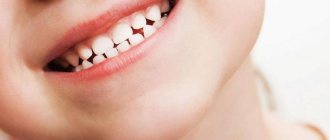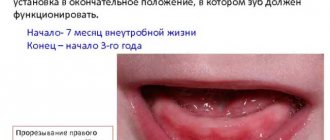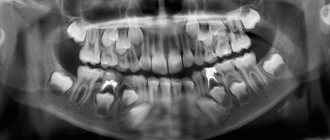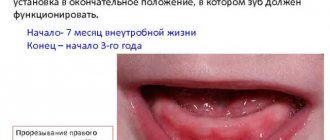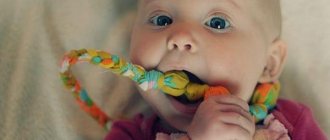Why a child has no teeth: the most common reasons
- Sometimes the reason lies in nutrition. Breastfed babies' teeth come out a little later than bottle-fed babies' teeth.
- Sometimes the delay is associated with a previous illness, intestinal dysfunction, improper metabolism or vitamin D deficiency.
- In some cases, late eruption is the result of pathologies during the mother's pregnancy. In this case, the sequence may be disrupted, and sometimes the rudiments of teeth are completely absent.
- If the tooth is initially located in the gum not vertically, but horizontally, which also occurs, it will erupt after 10-11 months.
- It is extremely rare that there are no teeth due to congenital adentia (genetic predisposition).
When do the first teeth appear?
It is widely believed that a baby's first teeth should appear at six months. If a child is 7 months old and has no teeth, parents begin to worry.
Baby teeth begin to form in utero long before they become visible. Their rudiments appear already in the sixth week after fertilization. Over the next months, gradually, layer by layer, they are covered with hard enamel. A newborn's baby teeth are already formed.
A little later, roots begin to form. As they grow, they slowly push out the top of the tooth, which breaks through the gum. It happens that everything happens so quickly that the child is born with one or two teeth.
Newborn with teeth
Timing of the eruption process
There are average periods for the appearance of teeth, which are the norm.
Important! Each child is individual. It will be normal for a 4-month-old baby to erupt the first teeth and for a 10-month-old baby too.
Average terms:
- At birth, teeth are not visible. They are partially formed, but are located inside the gum;
- The first teeth appear on average between the fourth and seventh months (most often around 6 months of age). First, 4 central incisors emerge, two each below and above;
- At approximately seven or eight months, the 4 lateral incisors emerge;
- When a child is about a year old, his first 4 molars begin to grow. This leaves free space between them and the lateral incisors;
- This space contains 4 canines, which usually emerge at approximately 1 year and 4 months;
- At about 2 years of age, the second molars begin to grow;
- At the age of 3 years, a child should have all 20 baby teeth.
Teething pattern
Important! In children with late teething, they can all come out almost simultaneously.
Number of teeth in a 7 month old baby
Experts advise determining the average number of teeth a baby has, corresponding to the age norm, by subtracting the number 4 from his age. For a 7-month-old child, the norm will be either 1-4 teeth or their complete absence.
How a dentist can help
If you are not ready to wait a year, seek help from a good pediatric dentist. The specialist will take an X-ray of the jaw to ensure the presence of tooth buds. If everything is fine, all you have to do is calmly wait for the process to begin - gum enlargement and increased salivation. Now it's time to help the baby:
- a ring stimulator will moderate itching, reduce discomfort and speed up teething;
- You can gently massage your child’s gums with a clean finger or a small spoon;
- stimulates tooth growth and fortified complementary foods - healthy juices and purees. While there are no teeth, solid complementary foods cannot be introduced.
How to determine the delay in teething
If a child is 1.5 years old and still does not have a single tooth, then this is a serious reason to seek advice from a dental clinic.
The normal period for the appearance of the first teeth in the oral cavity is considered to be from 4 to 16 months, subsequent teeth appear gradually after the first.
Permanent teeth begin to grow by the age of 6-7 years.
A slight discrepancy with the established deadlines is not a reason to sound the alarm; you should worry if the child has a complete absence of teeth.
How many teeth should a child have at 4 years old?
In children of 4 years of age, the number of teeth remains the same as at 3 years of age, that is, 20 milk teeth. Interdental spaces may already appear. Parents should wean their children from bad habits that can cause the growth of crooked permanent teeth.
At this age, you should give up the pacifier, do not allow the child to suck fingers, etc. If any problems arise, take your child to the dentist.
What should parents do?
It is necessary to pay attention to the presence of the factors listed above. There is no need to sound the alarm when a child has fewer teeth than he should have at his age. If there are no teeth at all by the age of one year, you need to act like this:
- Visit a doctor and get examined by him.
- Donate blood and urine for tests.
- Take an x-ray for the dentist.
If no abnormalities are detected in the body, then these are characteristics of the body. To speed up tooth growth, the doctor may prescribe vitamins and calcium. Parents can provide solid food. This way, the body can quickly receive a signal that it will need teeth.
When teeth first appear, the baby experiences pain. He will sleep poorly and cry constantly. His temperature will rise and his gums will swell.
Parents can do the following to calm him down:
Do you feel nervous before visiting the dentist?YesNo
- Give painkillers. The pediatrician must prescribe the medication. A lotion made from chamomile decoction or tea based on such a plant may be sufficient.
- When the pain does not subside and the temperature rises, you need to call an ambulance.
- You need to massage your gums with washed hands.
- The baby will salivate profusely during this period, and therefore parents need to put bibs on the baby.
- The baby needs to buy a special rubber device for biting. The item must be kept clean at all times. You can also give bagels, apples or other fruits.
To read: White plaque on the lips: causes in adults
Sometimes take homeopathic medicines. This:
- Dantinorm. Relieves pain and improves bowel function.
- Dentokind. Relieves pain, eliminates chills.
Gels:
- Holisal. Kills germs and reduces pain. Allergies may occur when consumed.
- Pansoral. Contains herbal extracts (chamomile, marshmallow, saffron). Do not give to a child under 4 months.
- Baby doctor. Also contains plant extracts and water (calendula, plantain, marshmallow). Relieves inflammation from gums. Give to baby after 3 months.
Traditional recipes:
- To soothe the gums, lubricate them with honey.
- Wipe the skin around the mouth with cream to prevent irritation from saliva.
- Gnaw the strawberry root.
- Massage the gums with a tampon with peroxide.
- Rinse your mouth with chamomile infusion.
Such procedures should be carried out during the first 2-3 days after the start of tooth eruption. Then the pain and symptoms subside.
Deviations
Pediatricians believe that a deviation from the norm will be a period of 6 months. Such delays should not alarm parents. If there are no teeth in a year, then it is important to undergo an examination and consult with specialists.
If partial adentia (no processes) is detected, the doctor prescribes a comprehensive treatment, which makes it possible to speed up the process of tooth formation. Sometimes, in order for the teeth and jaw to form correctly, temporary dentures may be prescribed to compensate for the lack of teeth and help the baby chew food.
To read: Features of teeth polishing
During treatment, the child needs to be in the fresh air and take more vitamins. Gum massage is useful.
When the first incisors appear before 3 months, this should alert you.
This situation indicates that the baby has pathologies in the endocrine system. But teeth appear earlier due to the individual characteristics of the body. There is no need to panic, but it is better to consult a pediatrician.
How many baby teeth should a child have?
Above we looked at when the first teeth can erupt. Based on this, it is clear that all monthly data on dental growth are approximate. After all, some children don’t get their first tooth until they are one year old, or even later.
According to the rules, the first incisors can appear at 6-8 months. And by the age of two and a half, the baby should have grown 20 baby teeth. The remaining indigenous 10-12 grow up to 32 years. The latest ones are wisdom teeth, they are the ones that cause us a lot of trouble with their appearance.
IMPORTANT: For some people, the norm is 28-30 teeth, the remaining 4 never appear.
Why don't teeth grow?
The period of appearance of incisors depends on whether the baby suffered infectious diseases in the first days of life. This is affected by the quality of the water and food he consumes. An important point is the course of pregnancy. If the mother had a lack of calcium in her body during this period, the baby’s teeth may erupt later.
In the embryo, processes begin to form at 7 weeks. On examination, small enamel organs can be seen on each jaw. At week 23, teeth form in place of the processes. If during this period the fetus is affected by negative factors, then pathology will appear.
It leads to the fact that the rudiments of teeth are not formed.
Diagnosis and treatment
To diagnose the disease, the dentist needs a detailed examination of the patient’s oral cavity. The doctor asks the patient a number of things:
- causes and timing of tooth loss;
- information about previous diseases;
- data on dental prostheses previously used by the patient.
During the examination, the dentist notes the asymmetry of the face, the severity of the chin and nasolabial folds, the degree of reduction in the height of the lower part of the face, the presence of a jam, the nature of the closure of the lips, the topography of the transitional fold, the degree of mouth opening, the nature of the jaw relationship. The specialist also determines the presence of crunching in the joints, pain when moving the lower jaw and diagnoses the degree of atrophy of the alveolar processes.
The examination necessarily includes palpation of the oral cavity and radiography of the TMJ. Based on the data obtained, the doctor determines further treatment tactics (prosthetics), selects the appropriate type of prosthesis and impression material for the patient.
Treatment of adentia in children
It is important for parents to understand that treatment of children who experience pathological tooth loss must be carried out without fail. For example, if a child lacks primary teeth in the anterior and lateral segments, the row may not form correctly during adolescence.
Children's adentia is characterized by:
- delay in changing permanent teeth;
- asymmetrical teething;
- unilateral preservation of primary teeth;
- non-loss of a baby tooth and its fusion with a depression in the jaw bone.
If at least one of these signs is detected, the child should definitely be shown to an orthodontist.
The choice of orthopedic design depends on the type of pathology and the condition of the small patient’s oral cavity. Children most often have fixed bridges installed - cantilever or sliding. To fix the structure, crowns are installed. Children respond well to prosthetics and adapt well to new designs.
Bridges can also be installed in young patients, but such designs are more suitable during the period of late mixed and permanent dentition. The most successful designs are considered to be sliding bridges. The only drawback of such a system is the formation of a gap when the structure moves apart and food gets into it.
Bridges are sometimes installed for preventive purposes to preserve space in the dentition.
During the period of early mixed and temporary dentition, removable plate dentures are used, which do not retard the growth of the jaw bones.
